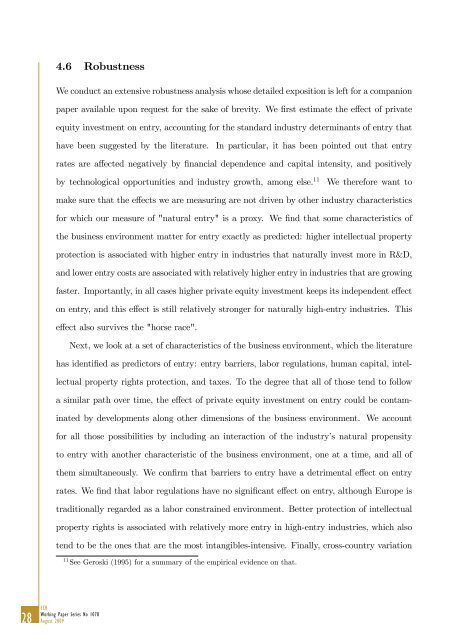On the real effects of private equity investment: evidence from new ...
On the real effects of private equity investment: evidence from new ...
On the real effects of private equity investment: evidence from new ...
- No tags were found...
You also want an ePaper? Increase the reach of your titles
YUMPU automatically turns print PDFs into web optimized ePapers that Google loves.
4.6 RobustnessWe conduct an extensive robustness analysis whose detailed exposition is left for a companionpaper available upon request for <strong>the</strong> sake <strong>of</strong> brevity. We …rst estimate <strong>the</strong> e¤ect <strong>of</strong> <strong>private</strong><strong>equity</strong> <strong>investment</strong> on entry, accounting for <strong>the</strong> standard industry determinants <strong>of</strong> entry thathave been suggested by <strong>the</strong> literature.In particular, it has been pointed out that entryrates are a¤ected negatively by …nancial dependence and capital intensity, and positivelyby technological opportunities and industry growth, among else. 11We <strong>the</strong>refore want tomake sure that <strong>the</strong> e¤ects we are measuring are not driven by o<strong>the</strong>r industry characteristicsfor which our measure <strong>of</strong> "natural entry" is a proxy. We …nd that some characteristics <strong>of</strong><strong>the</strong> business environment matter for entry exactly as predicted: higher intellectual propertyprotection is associated with higher entry in industries that naturally invest more in R&D,and lower entry costs are associated with relatively higher entry in industries that are growingfaster. Importantly, in all cases higher <strong>private</strong> <strong>equity</strong> <strong>investment</strong> keeps its independent e¤ecton entry, and this e¤ect is still relatively stronger for naturally high-entry industries. Thise¤ect also survives <strong>the</strong> "horse race".Next, we look at a set <strong>of</strong> characteristics <strong>of</strong> <strong>the</strong> business environment, which <strong>the</strong> literaturehas identi…ed as predictors <strong>of</strong> entry: entry barriers, labor regulations, human capital, intellectualproperty rights protection, and taxes. To <strong>the</strong> degree that all <strong>of</strong> those tend to followa similar path over time, <strong>the</strong> e¤ect <strong>of</strong> <strong>private</strong> <strong>equity</strong> <strong>investment</strong> on entry could be contaminatedby developments along o<strong>the</strong>r dimensions <strong>of</strong> <strong>the</strong> business environment. We accountfor all those possibilities by including an interaction <strong>of</strong> <strong>the</strong> industry’s natural propensityto entry with ano<strong>the</strong>r characteristic <strong>of</strong> <strong>the</strong> business environment, one at a time, and all <strong>of</strong><strong>the</strong>m simultaneously. We con…rm that barriers to entry have a detrimental e¤ect on entryrates. We …nd that labor regulations have no signi…cant e¤ect on entry, although Europe istraditionally regarded as a labor constrained environment. Better protection <strong>of</strong> intellectualproperty rights is associated with relatively more entry in high-entry industries, which alsotend to be <strong>the</strong> ones that are <strong>the</strong> most intangibles-intensive. Finally, cross-country variation11 See Geroski (1995) for a summary <strong>of</strong> <strong>the</strong> empirical <strong>evidence</strong> on that.28 ECBWorking Paper Series No 1078August 2009















